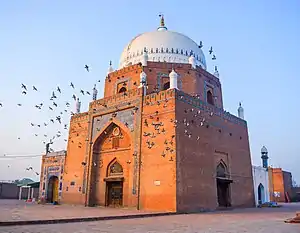Multan Division
ملتان ڈویژن | |
|---|---|
 Shrine of Bahauddin Zakria | |
| Country | |
| Government | |
| • Type | Divisional Administration |
| • Commissioner | Engineer Abdul Aamer Khattak (BPS-20 PAS) (PAS) |
| • Regional Police Officer | Muhammad Suhail Chaudhry (BPS-20 PSP) |
| Area | |
| • Total | 17,935 km2 (6,925 sq mi) |
| Elevation | 150 m (490 ft) |
| Highest elevation | 252 m (827 ft) |
| Population (2017)[1] | |
| • Total | 12,265,161 |
| • Density | 680/km2 (1,800/sq mi) |
| Website | multandivision |
Multan Division is an administrative division of Punjab Province, Pakistan. The reforms of 2000 abolished the third tier of government but the division system was restored again in 2008.[2][3]
Districts
It consists of the following districts:[4]
| District | Area (km²) | Population (2017)[1] |
|---|---|---|
| Multan | 3,721 | 4,745,109 |
| Khanewal | 4,349 | 2,921,986 |
| Vehari | 4,373 | 2,897,446 |
| Lodhran |
1,790 | 1,700,620 |
| Total | 14,233 | 12,265,161 |
History
Multan Division was created during the British colonial rule in the South Asia. During British rule, initially the districts of Jhang, Muzaffargarh, Mianwali[5] and all the districts of present day Dera Ghazi Khan Division (Rajanpur, Jampur, Kot Addu, taunsa, Layyah) collectively formed districts of Multan Division. In 1982 new Dera Ghazi Khan division was formed.[6] Sahiwal region was part of the division till 2008 when separate Sahiwal division was created. The division included within its limits Sulaiman mountain range extending towards Balochistan border. Total land area of Division was 76,500 Km Square according to statistics of 1901.
The headquarters of the Commissioner were at Multan (or in the hot season, at Fort Munro). The Division was abolished in 1884, but reconstituted in 1901. According to the 1881 census of India the population of the area now included was 2,036,956, in 1891 it had risen to 2,277,605, and in 1901 to 3,014,675.
The division lay between 28°25' and 33°13 N and 69°19' and 73°39 E, the Sutlej divided it from Bahawalpur on the south-east, while the Indus flowed through the Division and partly along its border to the west.
Demographics
According to 2017 census, Multan division had a population of 12,268,173, which includes 6,243,053 males and 6,023,825 females. Multan division constitutes 12,163,327 Muslims, 97,278 Christians, 4,264 Ahmadi followed by 1,578 Hindus, 1,357 scheduled castes and 369 others.
Religions in Multan Division (2017)
Notable People
- Yousuf Raza Gilani (Ex-PM of Pakistan)
- Rafique Rajwana (Ex Governor Punjab)
- Shah Mehmood Qureshi (Foreign Minister of Pakistan)
- Javed Hashmi (Senior Politician)
- Inzamam ul Haq ( Crickter)
- Waqar Younis (Cricketer)
- Mian Usman Khalid Arain (Politician Chairman State Youth Parliament Multan Division)
- Mirza Muhammad Farooq Jan.
CEO, Mehar Engineering
See also
References
- 1 2 "DISTRICT WISE CENSUS RESULTS CENSUS 2017" (PDF). www.pbscensus.gov.pk. Archived from the original (PDF) on 2017-08-29.
- ↑ "Firewall Notification" (PDF). health.punjab.gov.pk. Archived from the original (PDF) on 2015-04-16.
- ↑ "Punjab Government Plans to Carve a New District from Lahore". Archived from the original on 2010-06-03.
- ↑ Divisions/Districts of Pakistan Archived 2006-09-30 at the Wayback Machine
Note: Although divisions as an administrative structure has been abolished, the election commission of Pakistan still groups districts under the division names - ↑ "Imperial Gazetteer2 of India, Volume 11, page 248 -- Imperial Gazetteer of India -- Digital South Asia Library". dsal.uchicago.edu. Retrieved 2023-03-31.
- ↑ "Imperial Gazetteer2 of India, Volume 11, page 248 -- Imperial Gazetteer of India -- Digital South Asia Library". dsal.uchicago.edu. Retrieved 2022-09-12.
30°00′N 71°40′E / 30.000°N 71.667°E
